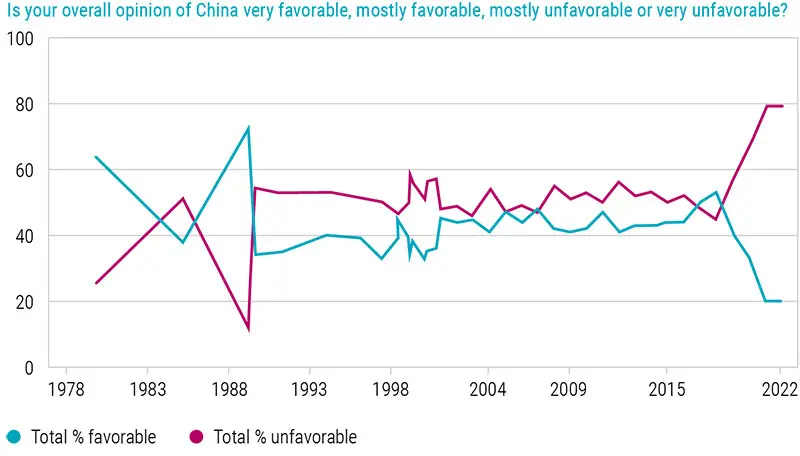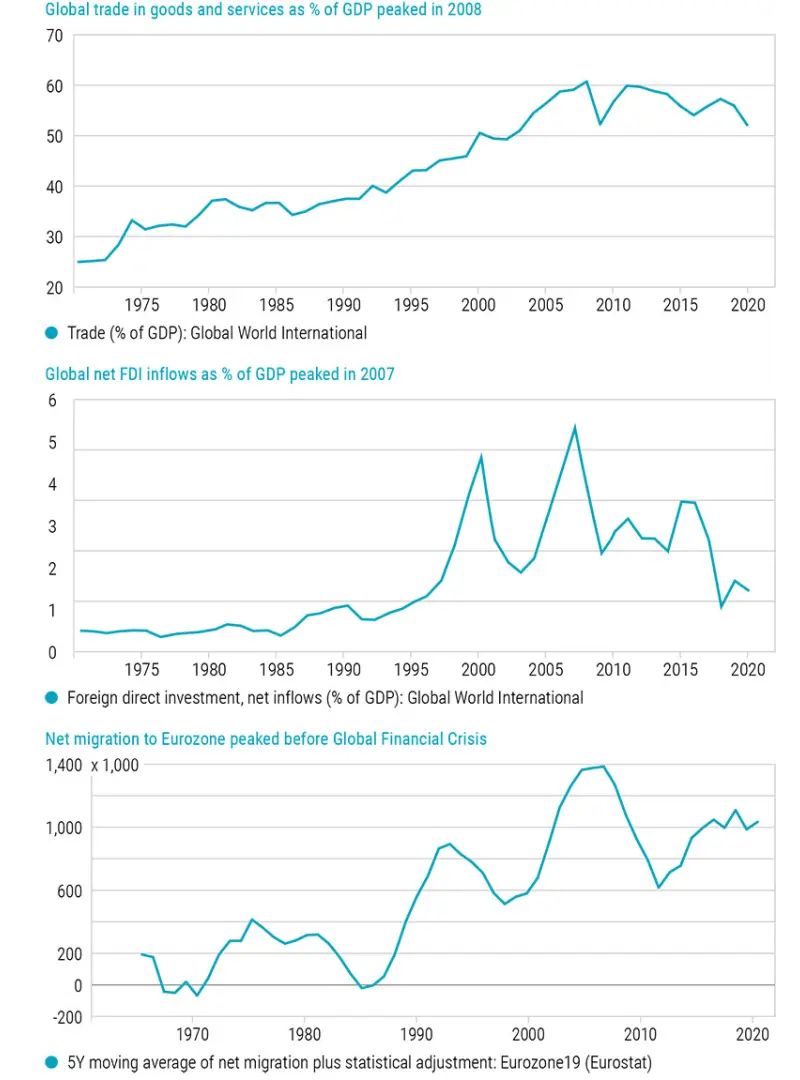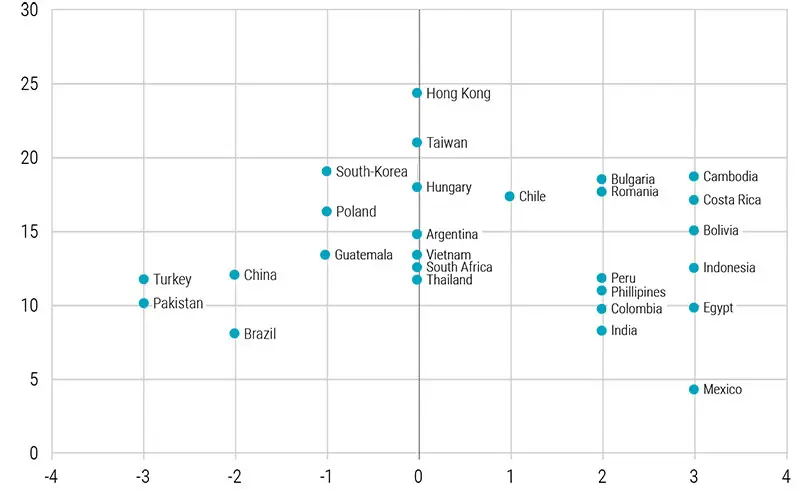Globalization is defined as the “movement of money, goods, people, ideas, technologies, and cultures across frontiers” and is a key component of international trade. The 19th century economist David Ricardo argued that it leads to greater global wealth, as each country specializes and trades in the goods in which it has a comparative advantage, a concept known as Ricardian efficiency.
Now it seems that the global economic order is turning anti-Ricardian. In contrast with the early 2000s, global leaders, governments and citizens no longer see globalization as a welcome force of nature that is futile to resist. The increasingly negative view of globalization is seen to have been instrumental in generating support for populist movements that helped Donald Trump to his 2016 presidential election by adopting his protectionist policy stance.
This can be seen in US popular opinion about China – much of whose economic success is due to exports – during the Trump administration, with 79% currently sharing an unfavorable view of the country. Creating a level playing field with China remains a priority in the Biden administration, with US President Biden declaring he would push back against Chinese “economic abuses”.
Big shift in US opinion about China

Source: Gallup
However, the tide of hyperglobalization had already started to recede before the Trump era, evidenced by a decline in the flows of goods, capital and people across borders. Global trade in goods peaked as a share of global GDP in 2008: global foreign direct investment (FDI) inflows peaked around 2007, and global migration flows to developed economies like the Eurozone also peaked before the global financial crisis. In the US, average annual immigrant population growth declined from 4.6% in the 1990-2000 decade to just 0.9% in 2015-2019.

Global trade in goods and services as a percentage of GDP peaked in 2008, while FDI inflows peaked around 2007. Source: Refinitiv Datastream, Robeco
Meanwhile, China’s globalization footprint has become more measured as its economy has grown. Richer economies typically turn more inward. Before the global financial crisis, China’s average net exports contribution of goods and services to GDP was 0.5%; post-crisis (2010-2022), this average contribution declined to 0.1%. US trade as percentage of its GDP has been declining since the 1970s.
Thus, the phenomenon of slowing globalization – or ‘slowbalization’ – is nothing new. Recent events such as Covid-19, the container ship that blocked the Suez Canal, and the Russian invasion of Ukraine have all had a reinforcing effect on global supply chain disruptions amid a surge in global goods demand. Increasing labor shortages in developed economies and precautionary inventory build-ups have added stress to a just-in-time supply chain system.
The centrifugal force of geopolitics
The centripetal pull of global economic cooperation is weakening as centrifugal forces like geopolitics and national interests become more entangled. China’s 2025 plan aims for strategic autonomy in 10 high-tech industries by achieving a 70% self-sufficiency ratio. The EU also wants to achieve strategic autonomy, while the US wants to switch its objective from fully liberalized trade to “free but secure” trade.
Corporate executives are also signaling an increasing focus on security concerns in supply chain management, with political stability emerging as a key driver. Supply chain realignments are also likely to focus more on sustainability. There is an obvious overlap between corporate commitments to reduce emissions and packaging in their supply chains and the Sustainable Development Goals such as SDG 13 (climate action) to reduce CO2 per capita.
Manténgase al día de las últimas perspectivas con actualizaciones mensuales por correoManténgase al día de las últimas perspectivas sobre inversión cuantitativa
Buying time to rethink just-in-time
Building more resilient and sustainable supply chains first and foremost changes the nature of globalization rather than its course. The share of imports as a percentage of GDP for the OECD countries has rebounded after the Covid-19 recession, with the overall share staying just below the 25-year globalization era trend.
Instead, companies seem to have bought time for a more drastic post-Covid supply chain redesign by mainly resorting to dual sourcing of materials and increasing inventory to sales levels, thereby broadening the number of supplier countries. Also, industries are following the example set by Elon Musk, looking to build resilience by increasing vertical integration to secure critical production inputs such as battery minerals and semi-conductor supply.
A more robust, but less efficient design of global supply chains will challenge corporate profitability. This elevates the risk that the anti-Ricardian streak in the coming re-design of supply chains could in the end turn out to be self-defeating.
Finding the sweet spot
We can analyze which countries tend to benefit from a different kind of globalization; one which also weighs resilience and sustainability, and thereby implicitly considers SDG impact-related factors such as the level of democracy and the nation’s environmental impact.
Countries that score well on both hard and soft factors will be in the sweet spot. We took the average rank of 27 emerging markets based on three efficiency metrics – their minimum wage in US dollars, their geographical distance to the US, and the size of their domestic labor force – and plotted that against their respective Robeco in-house SDG scores. The results can be seen in the chart below:
Ricardian efficiency rank versus SDG score

Source: Refinitiv Datastream, Robeco
Mexico emerges as the ideal candidate for US nearshoring – sourcing from a neighbor rather than globally – given the size of its labor force, outstanding SDG score, relatively attractive minimum wage level and geographical vicinity to the US market. The more interesting candidates in the sweet spot quadrant perhaps though lie in the bottom right corner, such as India, Indonesia, and Latin American countries like Peru.
Assets with an edge
We think the slowbalization trend that emerged after the global financial crisis, decelerating growth in cross-border flows, is likely to continue. From a cross-asset perspective, this implies that assets that do not react much to slowing global trade intensity could have an edge. Here, agricultural commodities (see also our special topic on food insecurity) stand out.
Conversely, emerging market debt in local currency could be particularly vulnerable in a multi-polar world as it is the most sensitive to global trade intensity. Total returns in this asset class are highly correlated with the issuing countries’ currency returns, which are ultimately driven by improving inflation differentials and real productivity growth catch-up, both of which are becoming more endangered in a fragmenting global economy.
In terms of sectors, technology emerges as the most negatively correlated with overall trade intensity, which has allowed it to defy the slowdown in overall global trade in goods and services as a percentage of global GDP. This is illustrated by the fact that international trade in digitally deliverable services has outpaced the overall exports of services during 2005-2019.
Steering an oil tanker
In summary, global value chains are like oil tankers: they need careful navigation. Therefore, shifts in the nature of slowbalization will be gradual, with companies buying time in the near term through precautionary hoarding and dual sourcing.
A pivot away from China could increasingly benefit countries with a better SDG profile, geographical proximity to the US or Europe, and attractive unit labor costs compared to China. Countries that are already relatively self-sufficient and/or have a technology tilt, such as the US, could have an edge as trade in the digitalization of services keeps outpacing growth in global goods trade.
This article is an excerpt of a special topic in our five-year outlook.
